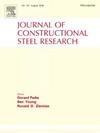Investigating seismic performance of a novel self-centering shear link in EBF utilizing experimental and numerical simulation
IF 4
2区 工程技术
Q1 CONSTRUCTION & BUILDING TECHNOLOGY
引用次数: 0
Abstract
This paper introduces an innovative self-centering shear link (SC-SL) that combines the self-centering SMA braces (SCB) and very short shear link with shear slotted bolted connection (VSSL-SSBC), commonly used in the eccentrically braced frames (EBFs). Four SC-SL specimens differing in bolt pretension and loading displacement were designed to investigate the seismic performance, enabling the acquisition of hysteresis curves, skeletal curves, secant stiffness curves and energy dissipation capacity of the SC-SL. Additionally, extensive parametric studies, validated by finite element (FE) modeling technique, were conducted to investigate the main influencing parameters of the SC-SL. Test results indicated that the VSSL in the VSSL-SSBC remained in the slip stage without any relative deformation and yielding during the slip stage, whereas slip deformation, web yield, and web and flange buckling occurred during the non-slip stage. The deformation and stress of the SMA wires in the SCB increased gradually and remained in tension throughout the loading process. Hysteresis curves of the SC-SL exhibited elastic and elastic-plastic during the slip stage, and elastic, elastic-plastic, and strengthening stages during the non-slip stage. In addition, enlarging the SMA areas can enhance the bearing capacity and reduce the residual deformation of SC-SL during both slip and non-slip stage. Finally, the simplified mechanical models of SC-SL were proposed and validated, indicated that the proposed equation was in good agreement with the FE simulation results, with a maximum error of 8.99 % and 4.86 % during the slip and non-slip stage, respectively.
利用实验和数值模拟研究 EBF 中新型自定心剪力连接件的抗震性能
本文介绍了一种创新的自定心剪力连杆(SC-SL),它结合了偏心支撑框架(EBF)中常用的自定心 SMA 支撑(SCB)和带剪力槽螺栓连接的超短剪力连杆(VSSL-SSBC)。为了研究 SC-SL 的抗震性能,设计了四种螺栓预拉力和加载位移不同的 SC-SL 试样,从而获得了 SC-SL 的滞后曲线、骨架曲线、正弦刚度曲线和耗能能力。此外,还通过有限元(FE)建模技术进行了广泛的参数研究,以调查 SC-SL 的主要影响参数。试验结果表明,VSSL-SSBC 中的 VSSL 始终处于滑移阶段,在滑移阶段没有发生任何相对变形和屈服,而在非滑移阶段发生了滑移变形、腹板屈服以及腹板和翼板屈曲。在整个加载过程中,SCB 中的 SMA 线的变形和应力逐渐增加,并保持在拉伸状态。SC-SL 的滞后曲线在滑移阶段表现为弹性和弹塑性,在非滑移阶段表现为弹性、弹塑性和强化阶段。此外,扩大 SMA 面积可提高 SC-SL 的承载能力,并减少其在滑移和非滑移阶段的残余变形。最后,提出并验证了 SC-SL 的简化力学模型,结果表明所提出的方程与 FE 仿真结果吻合良好,在滑移和非滑移阶段的最大误差分别为 8.99 % 和 4.86 %。
本文章由计算机程序翻译,如有差异,请以英文原文为准。
求助全文
约1分钟内获得全文
求助全文
来源期刊

Journal of Constructional Steel Research
工程技术-工程:土木
CiteScore
7.90
自引率
19.50%
发文量
550
审稿时长
46 days
期刊介绍:
The Journal of Constructional Steel Research provides an international forum for the presentation and discussion of the latest developments in structural steel research and their applications. It is aimed not only at researchers but also at those likely to be most affected by research results, i.e. designers and fabricators. Original papers of a high standard dealing with all aspects of steel research including theoretical and experimental research on elements, assemblages, connection and material properties are considered for publication.
 求助内容:
求助内容: 应助结果提醒方式:
应助结果提醒方式:


